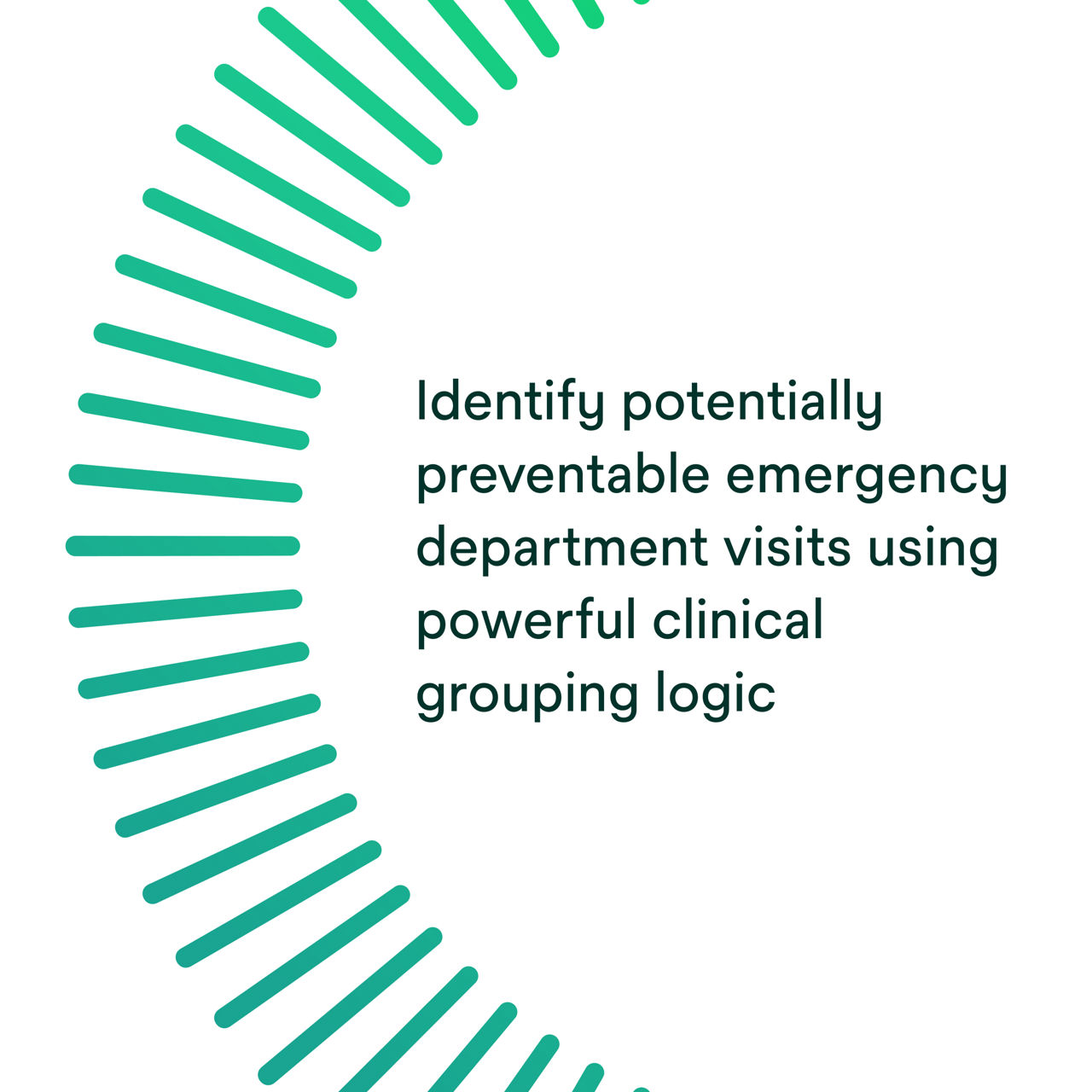3M™ Potentially Preventable Emergency Department Visits (PPVs)

Product details
All about 3M PPVs
3M PPVs are emergency department visits for conditions that could otherwise be treated by a care provider in a nonemergency setting. 3M PPVs may also result from a lack of adequate care or ambulatory care coordination, such as access to urgent care facilities, availability of primary care physicians, etc. 3M PPVs include visits that could have been reduced or eliminated if adequate patient monitoring and treatment (e.g., medication management) had been available. High 3M PPV rates may therefore represent a failure of the ambulatory care provided to the patient.
3M PPVs can be used by payers, employers, government agencies, researchers, integrated health delivery systems (e.g., managed care organizations and accountable care organizations) and residential nursing care facilities (e.g., nursing facilities, intermediate care facilities, and residential treatment centers). For example, employers or government insurance programs can use 3M PPVs to measure the performance of contracted integrated health delivery systems or residential nursing care facilities. In turn, integrated health delivery systems and residential nursing care facilities themselves can use the 3M PPV methodology to improve their own performance by improving outcomes from year to year.
Here are a few examples of the value the 3M PPV methodology can bring to customers:
- Quantifying opportunities for improvement. In the Medicare program, 55 percent of ED visits (excluding those patients who are admitted) were defined as potentially preventable, suggesting to the Medicare Payment Advisory Commission (MedPAC) that “ample opportunities” exist for improvement in the ambulatory care provided to Medicare beneficiaries.
- Understanding population health. The New York Department of Health reports risk-adjusted 3M PPV rates by county for both the all-payer and Medicaid populations, with reports dating back to 2011.
- Managing managed care. The Texas Medicaid program reports risk-adjusted 3M PPV rates for Medicaid-managed care organizations along with detailed drill-down capability and downloadable data files.
- Measuring outcomes in long-term care. In analyzing data for more than 400,000 Medicare nursing facility residents, Solventum researchers found considerable variation both within and across states in risk-adjusted 3M PPV rates. One implication: Medicare’s method of assigning nursing facility quality scores should say more about outcomes.
While 3M PPV classification logic is the same for every client, an organization can use different versions of the methodology and apply their own reimbursement calculation tables. Solventum always recommends that clients use the latest version of the software, but each organization can decide how to apply it (for research, public reporting, reimbursement, or a combination). Note: At present, Solventum does not offer software that replicates a specific organization’s PPV analysis.
3M PPVs are integrated with the other Solventum patient classification methodologies.
- 3M PPVs, along with the 3M™ Potentially Preventable Admissions and 3M™ Potentially Preventable Services, are the 3M™ Population-focused Preventables (PFPs). Solventum offers a suite of five Potentially Preventable Event methodologies, also including the 3M™ Potentially Preventable Complications (PPCs) and 3M™ Potentially Preventable Readmissions (PPRs). All 3M PPE methodologies are used to measure and reduce costly, clinically significant adverse outcomes.
- 3M PPVs are distinct from the 3M™ Potentially Preventable Revisits to the Emergency Department (PPR EDs), a component of the 3M PPR methodology that measures potentially preventable returns to the hospital (inpatient or ED) after discharge.
- The 3M PPVs are defined using the 3M™ Enhanced Ambulatory Patient Groups (EAPGs) methodology for ambulatory visits.
3M PPVs are available in the following Solventum products:
- 3M™ 360 Encompass™ System
- 3M™ Core Grouping Software (CGS)
- 3M™ Grouper Plus Content Services (GPCS)
- 3M™ Data-to-Action Solution
Available to Licensees on the Solventum customer support website:
- PFP Methodology Overview
- PFP Definitions Manual
- PFP Setup Guide
- PFP Summary of Changes
Solventum experts are available to advise health plans, government agencies and other interested parties on how to obtain maximum value from the use of 3M PPVs. For example, Solventum consultants can help you measure the incidence of potentially preventable emergency department visits, compare the results with appropriate benchmarks and design improvement programs. Solventum consultants can also help payers and other organizations measure 3M PPVs across health plans and other patient populations, design pay-for-outcomes incentive methods and facilitate learning collaboratives for provider groups.
The 3M PPV methodology can identify PPVs using standard, inpatient claims data derived from institutional and professional claims (i.e., the UB-04 and CMS-1500 paper forms and their corresponding X12N 837 electronic formats). Consistent, unique patient identifiers are essential. Comparing 3M PPV rates across different populations requires the 3M™ Clinical Risk Grouping (CRG) Software to perform risk adjustment by individual health status. Thus, 3M PPA analysis typically involves creation of a static data set comprising at least one full year of data. If available, pharmacy data in NCPDP format is optional but recommended. Note: 3M CRG and 3M PPV methodologies do not need to be built into the claim processing systems.
Inappropriate use of the emergency department has long been identified as a major problem in the health care system. The twin challenges have been exactly how to define “inappropriate” and who should be held responsible. Many payers have penalized the hospital or the patient for individual visits deemed inappropriate, but this approach can clearly be unfair. In 2012, Solventum met these challenges by releasing the 3M™ Potentially Preventable Emergency Department Visit (PPV) methodology as one of the three 3M™ Population-focused Preventables. The other two are 3M™ Potentially Preventable Admissions and 3M™ Potentially Preventable Services.
As with the other 3M Potentially Preventable Event methodologies, three core concepts are essential. First, we recognize that not all ED visits are potentially preventable. Second, what matters is not the individual visit, but rather the overall rate of potentially preventable ED visits. Instead of approaching quality with the mindset of “This should never happen,” we use a more realistic and meaningful approach of “This has happened too often.” Third, any comparisons across populations of patients must be risk-adjusted. In practice, that means that the actual 3M PPV experience of a population is compared with the experience that would be expected for a population with the same case mix.
The 3M PPV logic is divided into two phases:
1. Identify potentially preventable events
By definition, “ED visits” include only those visits where patients were treated and released. (Nationally, 14 percent of ED patients are admitted to the same hospital; their ED services are included within the inpatient stay.)
All ED visits are grouped using the 3M™ Enhanced Ambulatory Patient Group (EAPG) methodology. Of the 560 3M EAPGs (as of February 2019), many principal diagnoses within 196 3M EAPGs are considered potentially preventable in the general population. In a Minnesota all-payer analysis, the most common 3M PPVs were upper respiratory tract infections, abdominal pain, and musculoskeletal systems and connective tissue diagnoses such as back pain. When a population is under the care of a residential nursing care facility (such as a nursing facility, intermediate care facility, or residential treatment center), additional trauma, infections, and certain other diagnoses are considered potentially preventable.
2. Determine patient risk adjustment
In any rate-based comparison of outcomes, risk adjustment is essential for a fair comparison across populations. Although 3M PPVs are generally preventable, they will never be totally eliminated, even with optimal care. As a result, there will be a residual rate of 3M PPVs in even the best-performing systems. More importantly, the rate at which PPVs occur depends on the burden of illness of the population.
The 3M PPV software measures the burden of illness of each patient (and therefore of the population) using the 3M™ Clinical Risk Groups (CRGs). In 3M CRG v2.1, there are approximately 390 base 3M CRGs and 1,470 total 3M CRGs, taking into account severity levels. For example, 3M CRG 70602 describes a person with congestive heart failure, diabetes and chronic obstructive pulmonary disease, severity level 2. ED visits for this person are more likely to be preventable than for a person in severity level 5 (i.e., 3M CRG 70605).
The 3M CRGs can be rolled up into three levels of aggregation (i.e., approximately 676, 254 or 54 groups) and nine health status group levels. The aggregated 3M CRGs sacrifice some clinical precision, but with only a slight loss of explanatory power. Solventum recommends that the ACRG3 level of 54 groups (as of 2019) be used for setting risk-adjusted 3M PPV norms.
Further information on the 3M PPV logic is available in the 3M™ Population-focused Preventables Methodology Overview. Detailed information is available to licensees in the online 3M PFP definitions manual.
The 3M PPV clinical logic is maintained by a team of Solventum clinicians, data analysts, nosologists, programmers and economists. The methodology is updated annually to reflect changes in the standard diagnosis and procedure code sets as well as Solventum enhancements to the clinical logic.







